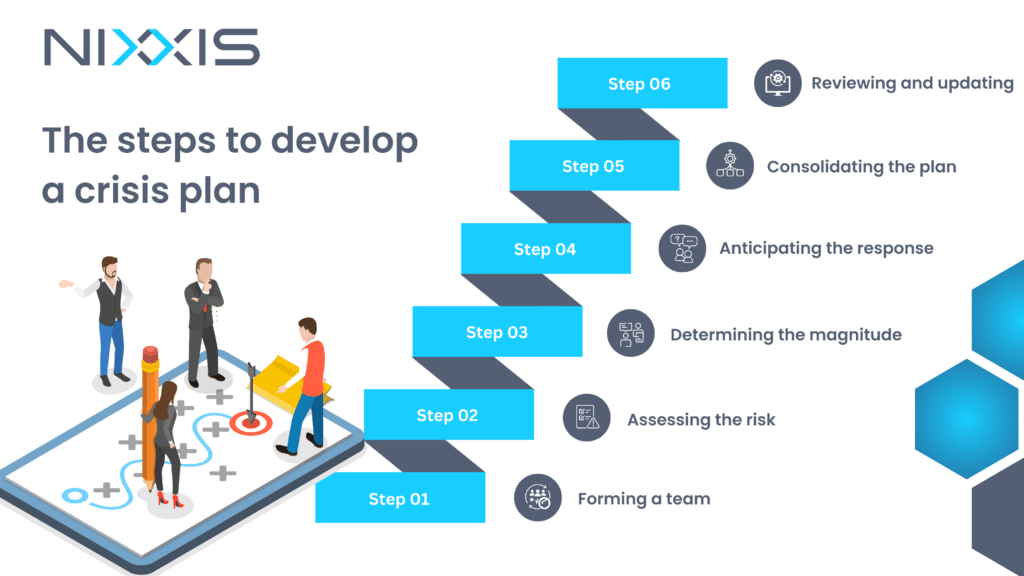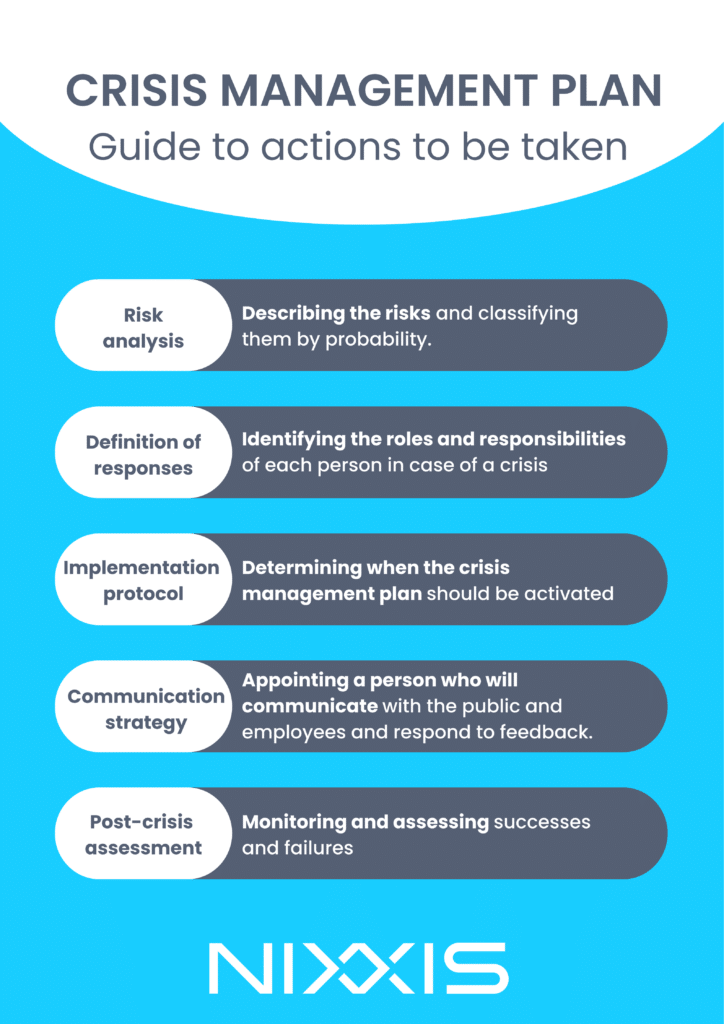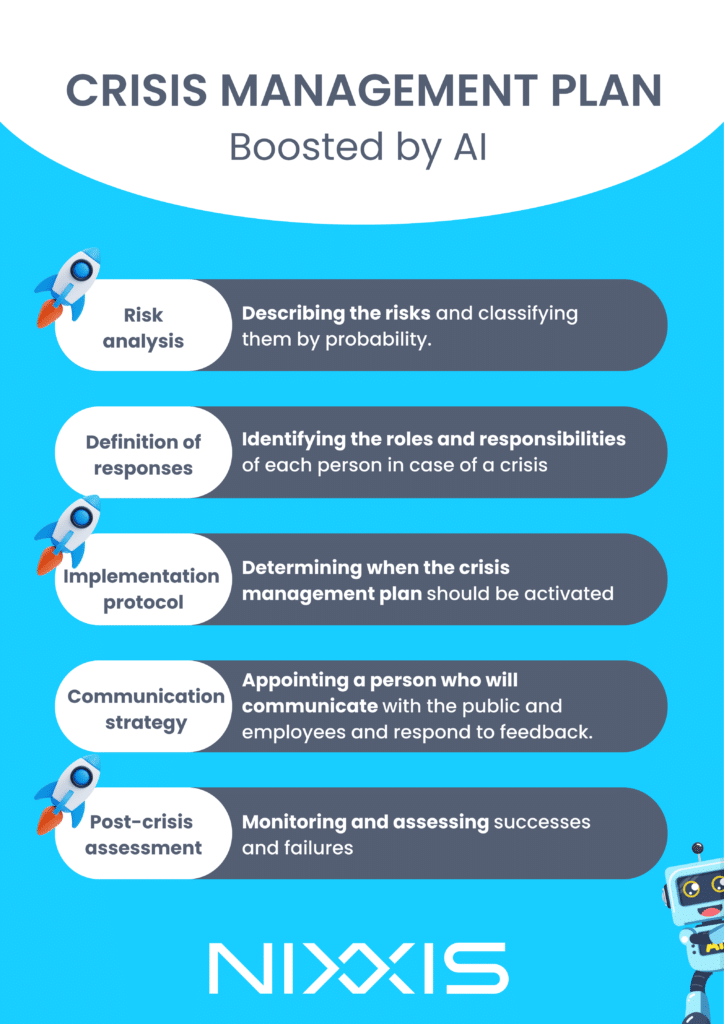Crisis management has become a major concern for businesses and organizations around the world. In a constantly evolving environment, characterized by increasing complexity and increased volatility, the risks of crises are omnipresent. Whether it is a global pandemic (the covid-19 crisis for example), a cyberattack, a natural disaster or even a technological failure, companies must be ready to face a multitude of unforeseen scenarios that could compromise their business. different levels. Obviously, contact centers are not spared.
In order to respond to these challenges, the implementation of a crisis management plan has become an essential necessity for any contact center concerned with its sustainability. This plan constitutes a strategic and operational framework aimed at preventing, anticipating and effectively managing crisis situations. In this context, the integration of specific processes, tools and resources allows call centers to minimize the negative impacts of a crisis and strengthen their resilience in the face of the situation experienced.
In this article, you will learn to recognize the different stages of crisis management, through the importance of developing a robust strategy and recent developments in this area. You will discover the growing role of artificial intelligence (AI) as an increasingly popular solution for businesses. Finally, we will highlight the importance of adaptability in a constantly changing environment, where the ability to quickly adjust to the reality of events is essential to ensure the long-term survival and prosperity of businesses.
1. The crisis management plan: the essential

Crisis management is an essential component of any company or organization, because it makes it possible to minimize potential damage to the company’s brand image, the implementation of current actions and in terms of cash flow. A crisis management plan therefore constitutes a very important tool for any entity wishing to be able to respond effectively to unforeseen and often destabilizing events, whether for teams or the company as a whole.
2. Develop your crisis strategy in just 6 steps

a) Identify the competent team
The first step in developing a crisis management plan is to build a dedicated, competent and responsive team. To ensure the effectiveness of the process, this must include the major players and representatives of different departments, namely certain members of human resources, communications, finance, general management, without forgetting the supervisors who can then guide the agents according to the decisions taken. Each member of the team must be trained to act quickly in the event of a crisis and direct the rest of the employees towards possible solutions. We recommend at Nixxis to organize regular simulations to maintain their skill level at all times.
b) Assess the risks...
It is essential to identify and assess the risks to which the company is exposed. This can include many threats, first and foremost health crises. During such an event, and depending on the scale of the aforementioned crisis, it is possible that teleworking will be the only option considered to ensure the safety of all advisors and maintain compliance with health rules. Several questions arise from this: is your contact center prepared for this sudden change? Are you equipped with a solution that allows your advisors to work from home? Will the voice quality be sufficient? Beyond health crises, there can also be natural disasters, cyberattacks or technological failures. In current events, cyberattacks are legion and target all types of sectors, but mainly health. Having a redundant infrastructure is strongly recommended in this context, so as not to lose your data and to be able to continue your calling campaigns with complete peace of mind. You may also be faced with an exploding call volume, as well as requests on chat or any other communication channel. You must therefore be able to react quickly to the situation.
c) … and the impact on commercial activity
Once the risks have been identified, it is important to determine their potential impact on the company’s commercial activity and its turnover. This assessment makes it possible to prioritize the risks and determine the measures to be taken for each of the risks incurred. This step also makes it possible to determine priorities in terms of business continuity and recovery.
d) Determine action commitments
Based on previous assessments, the team assigned to crisis management should develop a detailed action plan, defining the roles and responsibilities of each team member and the steps to follow, point by point. This action plan must include clear procedures to manage the situation, from notifying all stakeholders (business and technical) to implementing loss mitigation measures.
e) Consolidate your crisis plan
Once the action plan has been established, it should be consolidated by integrating appropriate monitoring and communication mechanisms. This ensures that the plan is operational and ready to be implemented on the D day. Project management tools can be used to track the progress of actions and ensure that each step is completed on time and correctly.
f) Take stock every year
Finally, a crisis management plan should be constantly reviewed and updated to reflect changes in the business environment and new emerging threats. Your contact center then remains agile and ready to face any type of crisis. Revisions should include a post-crisis analysis to identify the strengths and weaknesses of the plan and make necessary adjustments.
3. What elements make up the crisis management plan?
To facilitate its development, a crisis plan must contain crucial elements for the smooth running of its actions. In particular, we observe 6 important points which should help you in determining a suitable strategy.

a) Risk analysis
Risk analysis is the foundation of any crisis management plan. As explained previously, it consists of identifying potential threats and assessing their probability of occurrence and their impact on your contact center or customer service.
b) Appropriate responses
Each risk must be assigned to one or more possible responses. This may include measures such as evacuating premises, implementing business continuity plans or communicating with stakeholders. Call centers must also consider ethical and legal aspects when developing response strategies, so as to leave nothing to chance.
c) The implementation protocol
It defines the steps to take in a crisis, including the responsibilities of each team member and the communication channels to use when appropriate. It must be detailed to enable effective implementation of the plan.
d) The communication strategy
Communication is essential during these tense times and must be carried out both internally and externally. You must be transparent with your employees/advisors, clients, partners, but also with the media. It’s about your brand image and your reputation.
e) The post-crisis assessment
Once the crisis is over, it is important to conduct an evaluation to identify lessons learned and potential areas for improvement. You will thus strengthen the resilience of your society and be better prepared for future crises. Everyone’s feedback must be documented and used judiciously to update the plan and adjust internal processes.
4. The evolution of crisis management
Crisis management has evolved significantly over time, moving from a reactive to a proactive approach. Call centers now recognize the importance of advance preparation and planning to effectively deal with crises. Team efforts coupled with technological advances in artificial intelligence (AI) have also transformed the way companies approach this topic.
5. AI as an ally of choice in managing internal crises
AI is playing an increasingly important role in internal contact center crisis management, offering innovative solutions to anticipate, manage and mitigate the effects of critical situations. With its advanced data analysis, predictive modeling and process automation capabilities, it is truly a valuable ally for your organizational resilience and in minimizing the damage caused by crises. Here are some of the ways AI can be used in this context:
a) Risk detection and analysis
AI can be used to analyze data from various sources, such as social media, internal and external databases, real-time data (and call) feeds… to identify data signals. alert precursors of potential crises. Using machine learning algorithms, it spots trends, detects anomalies and can even accurately assess the likelihood of these critical situations occurring. In this case, within contact centers, AI algorithms can be used to monitor fluctuations in calls, or even anticipate call peaks.

b) AI-assisted decision making
During a crisis, knowing how to make a decision quickly is crucial to minimizing damage and restoring some stability. AI can help leaders and managers make the best choices by providing in-depth analytics, personalized recommendations, and what-if scenarios. For example, AI systems can evaluate different policy options and estimate their potential consequences, allowing decision-makers to choose the best approach to manage the crisis. AI can also be used to automate certain repetitive decision-making tasks, such as resource allocation or team coordination. In the specific case of a peak in requests, AI is able to automate responses to customers across all channels (chatbot, social networks, email, text messages, etc.) to reduce as much as possible the burden on advisors and their allow you to focus on important requests.
c) Information and communication management
AI can be used to analyze and filter information flows, identify reliable and verified sources, and deliver consistent and targeted messages to different audiences, both internal and external. For example, AI-powered chatbots can address customer and advisor concerns and provide immediate updates. Similarly, semantic analysis tools can be used to monitor online conversations and act quickly if participants in that exchange disclose misinformation.
d) Learning and continuous improvement
The strong point of AI remains its advanced analysis capabilities. After a crisis, it is able to report on performance to strengthen preparation and response to future crises. For example, machine learning algorithms can be used to identify recurrences and patterns of behavior, allowing customer services to anticipate future crises and adapt their strategy accordingly.
6. Conclusion
In conclusion, a crisis management plan must be an essential element in your strategy. By following the key steps and integrating the necessary human and material resources, you can strengthen your resilience and ability to deal with these complex situations, ensuring your long-term success. Traditionally, crisis management previously relied on human expertise and team skills. Often overloaded by the scale and complexity of the emergencies (including peak calls) to be handled and often poorly prepared (this goes without saying), the teams often made decisions in a hurry and under pressure from their colleagues… decisions sometimes subject to human error, which can aggravate the crisis rather than alleviate it. There is no doubt that with the advent of AI in this field, this dynamic has recently begun to change and the first results are more than positive.
Do you want to discover the full potential of AI for your business?
Do you want to discover the full potential of AI for your business?








